
THE CELLAR
We were asked to repair an arched vault and convert it into an amazing wine cellar in the belly of an well-established lodge in western Laikipia. The original structure had lost the critical geometry required for intersecting vaults and presented the problem of finishing the stone work onto what is known as a 'Welsh vault'. The opportunity stirred an old dream and admiration for the art of building vaults that I have loved since childhood. I didn't know until later how demanding the Welsh vault is and why it disappeared from architecture in the 18th Century.
The first task was to understand what was built, how to remedy the interconnection and outline the stone work of the arises and arches of the Welsh vault. We surveyed the space, getting a feel for the boundaries, and then spent over 60 hours searching through the internet to find some real information on how to calculate the geometry and describe the stone cutting required to the team of masons back at the workshop. The cutting schedule for the arises, the stone to prepare the skin of the vaults, the extrados which is critical to the true aesthetic and beauty of vaults - and when it's wrong, it's noticeably unappealing. It was bleak trawling hour after hour, digging in libraries and internet and finding nothing. I thought the inevitable call was pending. Then with one key word a world of information emerged, and I found a book written in 1876.
The end result of hours of drawing, months of cutting and some Egyptian style boulder moving was one of the most favourite moments of my career in building. We dropped the shuttering finally from inside the cellar, the now completed vault exposed, and the team lay down on the ground, looked up at the ceilings and said, ‘haki ya Mungu’ - roughly translated, this means "for the love of God".















